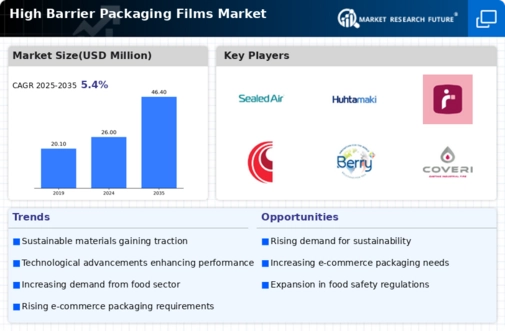Market Analysis
In-depth Analysis of High Barrier Packaging Films Market Industry Landscape
Customers' evolving eating preferences drive the preference for ready-to-eat food. The market is expected to grow rapidly due to working people's hectic lifestyles, students' willingness to spend more on processed and packaged food, and rising demand for comfort products. Ready-to-eat and ready-to-cook, ready-made packed food, instant food packages, and processed foods are in high demand since they are portable and cook quickly.
In recent years, demand for office or home food delivery and ready-to-eat and shelf-stable products has increased. After contact with the physical and chemical environment and other ambient conditions, processed food products lose quality and originality. Quality high-barrier packaging films can enhance the shelf life of packed products and keep food fresh.
High-barrier packaging films preserve food's taste, quality, flavor, texture, aroma, and enticing appearance, driving market growth.
High barrier packaging film market dynamics involve many aspects that affect supply, demand, and industry growth. High barrier packaging films are commonly used in the packaging industry because they protect items from moisture, oxygen, and other factors, extending their shelf life. Consumer need for convenient, long-lasting packaged food and beverages drives industry expansion. Food safety awareness and the need for sustainable packaging solutions also drive the high barrier packaging film market.
This market's dynamics depend on competition. As high barrier packaging film demand rises, manufacturers must innovate and distinguish to stay competitive. New and enhanced high barrier films meet the needs of pharmaceuticals, electronics, and agriculture thanks to material science and technology. Market participants engage much in R&D to improve these films' performance and address environmental and recyclability concerns.
Another important issue affecting high barrier packaging film sales is regulation. Food safety and environmental sustainability requirements require manufacturers to follow standards and certifications. This regulatory environment shapes product development and new player market entrance hurdles. Industry participants are also exploring eco-friendly alternatives due to the rising emphasis on circular economy concepts and plastic waste reduction, which affects the market landscape.
Global economic trends and trade dynamics shape the high barrier packaging films industry. Raw material prices, currency exchange rates, and geopolitical events affect production costs and pricing tactics. The global economy's interdependence requires market participants to monitor international trade policies and geopolitical changes, which can affect raw material supply and price.
Market dynamics depend on consumer choices and lifestyle changes. High barrier packaging films provide lightweight, portable, and easily disposable packaging, meeting the demand for on-the-go packaging. Additionally, the growing interest in health and wellbeing has increased demand for packed fresh produce and organic items, necessitating high-performance packaging materials that retain their freshness and nutritional content.


 Source: Secondary Research, Primary Research, Market Research Future Database, and Analyst Review
Source: Secondary Research, Primary Research, Market Research Future Database, and Analyst Review










Leave a Comment